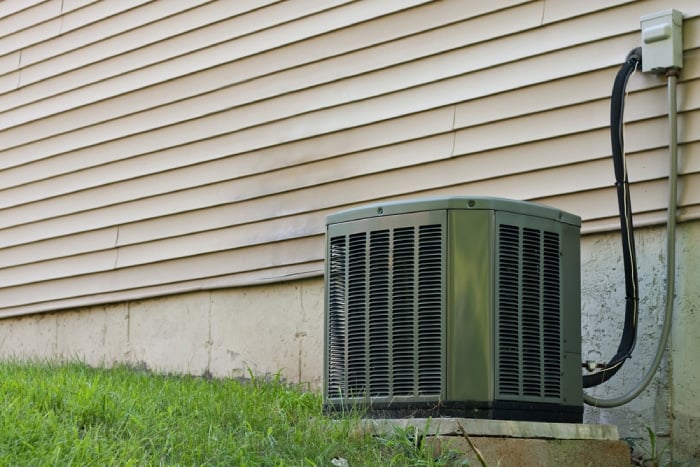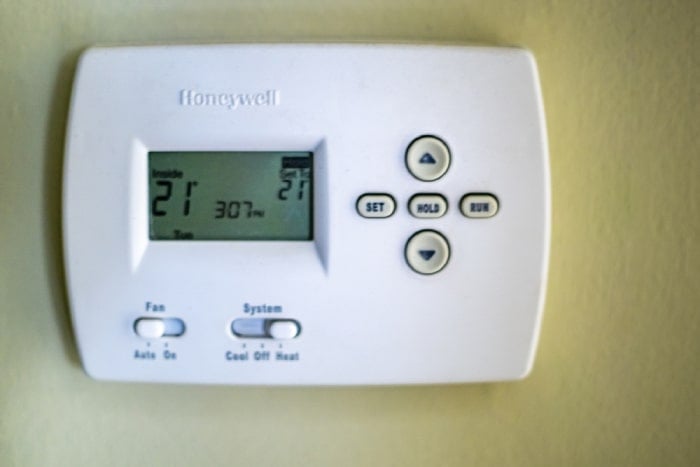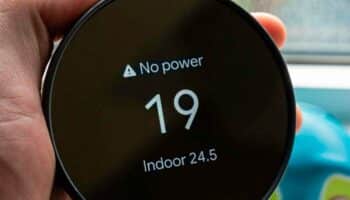We've independently reviewed this article to make sure it's as accurate as we can make it.
To find out more about our article creation and review process, check out our editorial guidelines.
Is your thermostat behaving like a snowflake? Or should I say, do you have a flashing snowflake on your thermostat?
If your thermostat is set to cooling and it’s not doing its job, how ironic is it that you’re presented with a blinking snowflake? If you’re AC isn’t working, shouldn’t they be flashing a flame at you?
Irony aside, don’t panic. There’s probably a very good—and short-term—reason for the snowflake. I’ll try to cover several major brands and explain what’s going on, so read on.
Thermostats typically show a flashing snowflake to indicate that it’s in Delay Mode. This occurs when the system is short cycling – turning on and off too quickly. This can be harmful to the equipment, so the flashing snowflake typically signals that your system is delaying turning back on for a while.
This typically lasts 5 minutes for cooling (to protect the compressor) or 2 minutes for heating.
But first, let me give you some technical info so you can understand what each manufacturer is telling you.
What is Short Cycling?
You’ve probably noticed that your furnace or central air conditioning cycles on and off. At least it should. Depending on how extreme your outdoor temperatures are, cycling can be up to about 20 minutes.

If it’s an exceptionally hot summer and your air conditioner has to work extra hard to keep your home cool, that 20 minutes could drop down to 10 or 12 minutes.
The same is true for a brutally cold winter. In order to keep your home at the set temperature of the thermostat, your furnace needs to work harder. As soon as it stops blowing warm air, the house cools faster because it’s so cold outside. So again, that 20-minute cycle could be 10 or 12 minutes.
Please note those times are just averages. Don’t be standing there monitoring your HVAC equipment and panicking because the cycle wasn’t 10, 12, or 20 minutes.
Short cycling is when that cycle happens faster than it should. Your furnace or air conditioner is turning on and off at a faster rate than is acceptable. This isn’t good for your system because it’s continuously working hard.
If your system works too hard for too long, it can cause damage. Expensive damage.
What Causes Short Cycling?
There are a few reasons. Some of them are simple to address—and some of them are not so simple.
- Your System is Incorrectly Sized. Here is where hiring the right HVAC professional in the first place comes into play. If your contractor installed equipment that is too big for your space, it will heat or cool that space quickly. That sounds like a good thing, right? Wrong. It will make your system short cycle.
- Your System Could be in Need of Repairs. Anything that has caused a power outage could cause a short cycle. Other problems may be issues with the breaker, problems with your condensate switch, a corroded flame sensor, or even something one of the kids or pets have put down a vent. Accidently, of course.
- Your Maintenance may Not be Up to Date. Things like dirty air filters can restrict airflow and cause your system to short cycle. Keep up with simple maintenance issues like cleaning and inspections.
- Problems with Your Thermostat. Does your thermostat need to be replaced? Or have you just installed a new one in a spot that isn’t optimal? Placing a thermostat in a spot that gets direct sunlight or is close to a heat or cold generating appliance can trick it into turning on and off prematurely.
What is Delay Mode?
Note that Delay Mode is also referred to as Cycle Delay.
Delay Mode is trying to protect your system from the potentially expensive damage mentioned above. Damage caused by your system is short cycling.
So don’t panic. It doesn’t mean that your system won’t heat or cool your home, it just means it’s taking a break and will do it eventually. Probably in under five minutes. And it will keep doing this until you fix whatever is causing your system to short cycle.
Remember, this feature is to protect your system and ultimately save you money. Yes, it’s probably annoying, but necessary. It shouldn’t last longer than around 5 minutes or so.
So if your thermostat is giving you a message that says something like delay mode—or it’s flashing a snowflake at you—it could be one of the general issues mentioned above. Or, depending on the manufacturer of your thermostat, it could be something more specific.
| General Causes of Short Cycling |
| System requires repair |
| System requires maintenance |
| Issues with your thermostat |
| Oversized system |
Below, I’ll list many popular thermostat manufactures and the causes they list for a flashing snowflake on your thermostat.
Honeywell Thermostats
If you have a blinking or flashing snowflake on your Honeywell thermostat, or the word heat/cool is blinking, it means your thermostat is in delay mode. Your system should cycle on in five minutes but check the possible causes above for delay mode.

Until you address the underlying cause, your thermostat will continue to switch to delay mode.
Emerson Thermostats
Emerson provides a thorough, 8-page manual on their thermostat. According to it, if your thermostat has a blinking/flashing snowflake or flame, your furnace or air conditioner has been put in lockout mode to stop your compressor or heat element from cycling too quickly. It will likely stay in lockout mode for 5 minutes.
Carrier Thermostats
As with other thermostats, your issue with a blinking or flashing snowflake on a Carrier thermostat is a delay of 5 minutes.
As you can see, it’s pretty common across thermostat manufactures to have this failsafe built-in.
Conclusion
So now that you know what a flashing snowflake on your HVAC thermostat means, you can take the proper steps.
And the steps aren’t just waiting 5 minutes until the system starts working again. Remember, you are getting that warning flash because there is a problem somewhere in your system that needs to be addressed.
If your current system was oversized, there isn’t much you can do about that, other than start again with a new system. However, you can address the other three causes of the flashing snowflake.
- If you haven’t been keeping up with routine maintenance, you need to start. However, you may have caused bigger problems than a filter that needs to be replaced.
- Have an HVAC contractor in to see if your system is in need of repair.
- Finally, make sure your thermostat is functioning properly. And that it isn’t near a heat source.
Thanks for reading. Please take a moment and check out the related articles below!







